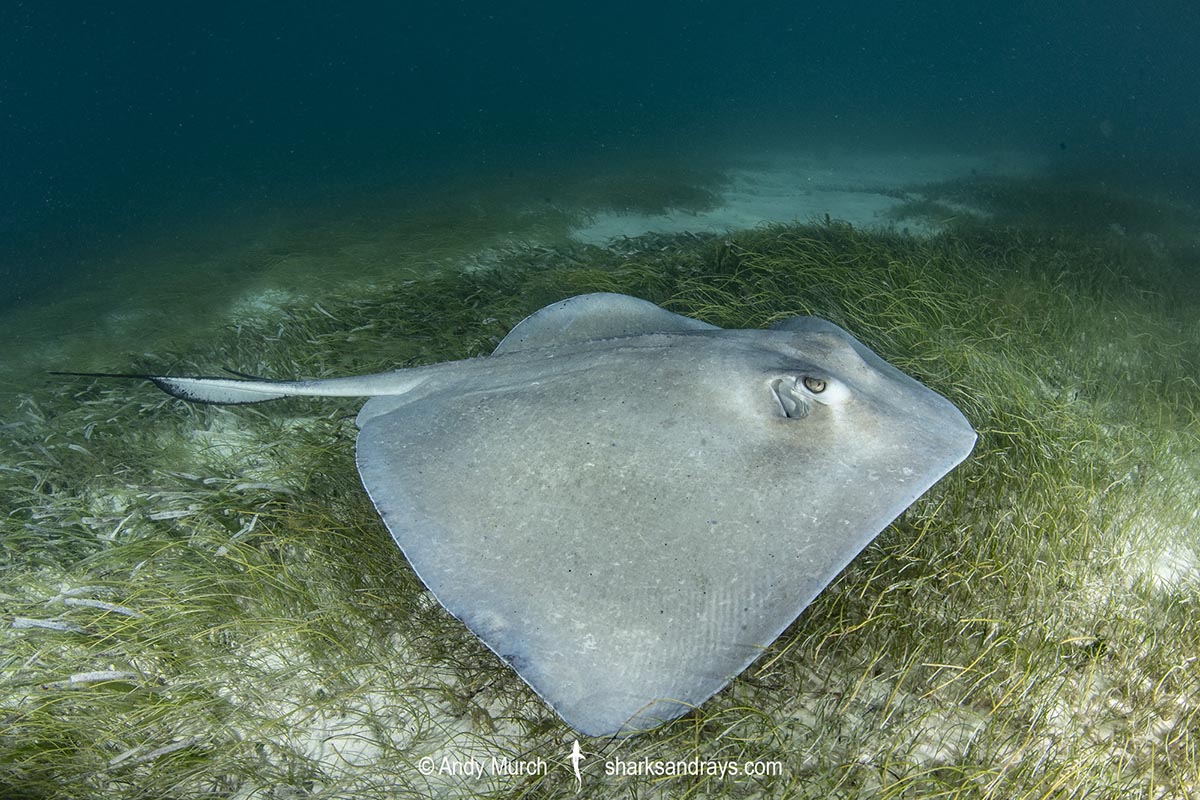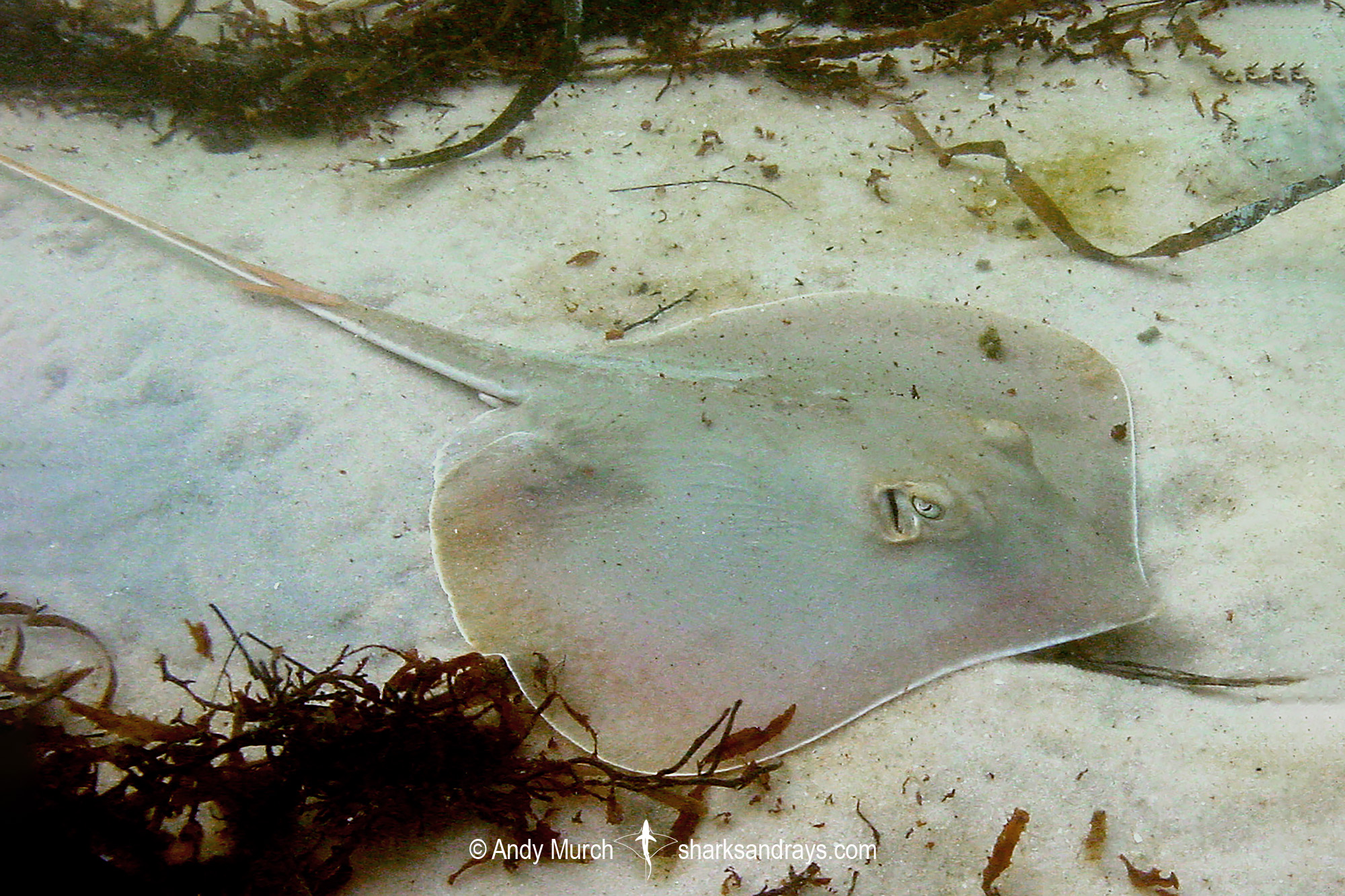Common name(s)
Bluntnose Stingray.
Identification
A medium-sized stingray with a kite-shaped disc that is slightly wider than long; disc width approximately 1.1 x length. Snout short and bluntly rounded with a protruding tip. Anterior margins of disc straight or weakly concave. Pectoral fin apices broadly rounded. Pelvic fins large with rounded apices.
Eyes medium-sized and protruding. Snout length 1.4-1.9 x combined eye and spiracle length.
Mouth with 5 oral papillae. Shallow labial furrows around mouth. Lower jaw weakly arched. Skirt shaped nasal curtain with a fringed margin. Nostrils oval-shaped, positioned slightly obliquely.
A row of very small thorns extend along midline from nape to caudal tail. Short row of small thorns on each shoulder. Tail tapering to end of ventral fold, then filamentous to tip. Tail length (when intact) approximately 1.3-1.7 x disc width. Ventral finfold short; deeper than tail height beyond caudal sting. Dorsal finfold short but prominent; slightly thinner than tail height beyond sting. 1-2 slender tail stings usually present.
Colour
Dorsum variable; grey, reddish-brown, or olive grey. Young animals generally paler, sometimes with bluish markings. Ventrum white, sometimes with a dark disc margin. Sides of tail white. Caudal finfolds and tail beyond caudal sting often dusky or black.
Size
Maximum disc width at least 78cm. Disc width at birth 15-17cm.
Habitat
Tropical to warm-temperate seas. On sandy or muddy substrates, in estuaries and close inshore. Intertidal to 130m.
Distribution
Western Atlantic. Found from Connecticut to Pernambuco, Brazil, including the Gulf of Mexico and Caribbean Islands. Apparently absent from the Caribbean coastline of Central America.
Conservation Status
NEAR THREATENED
The bluntnose stingray is captured in artisanal gillnet and commercial nearshore trawl fisheries, which are intense in the southern part of its range. In US waters, it has refuge from fishing in inshore waters that are not trawled. It is likely to be captured in artisanal fisheries in the southern Gulf of Mexico and it has likely to have declined by 31% over the past three generation lengths (32 years). In northern South America, there are no time series of trends in abundance. However, there have been declines noted in other stingrays in some areas of this region. This species likely suffers limited mortality in the Northwest Atlantic and Caribbean Sea which together comprise approximately one-third of its distribution. Overall, due to the moderate level of fishing pressure across two-thirds of its range, which in many areas are intense and unmanaged, particularly in northeastern Brazil, it is suspected that the Bluntnose Stingray is close to reaching the population reduction threshold due to levels of exploitation, and it is assessed as Near Threatened (nearly meeting Vulnerable A2bd).
Citation
Carlson, J., Charvet, P., Blanco-Parra, MP, Briones Bell-lloch, A., Cardenosa, D., Derrick, D., Espinoza, E., Herman, K., Morales-Saldaña, J.M., Naranjo-Elizondo, B., Pacoureau, N., Schneider, E.V.C. & Simpson, N.J. 2020. Hypanus say. The IUCN Red List of Threatened Species 2020: e.T60159A3090316. https://dx.doi.org/10.2305/IUCN.UK.2020-3.RLTS.T60159A3090316.en. Downloaded on 20 February 2021.
Reproduction
Matrotrophic aplacental viviparity. 2-3 pups per litter. Gestation approximately 10-11 months.
Diet
Diet consists mainly of marine worms, bivalves, crustaceans, and small fishes.
Behavior
Sedentary, poorly known.
Reaction to divers
Somewhat tolerant of divers if not approached too closely.
Diving logistics
Encounters with bluntnose stingrays are rarely reported because of their similarity to southern stingrays.
No areas have been identified where this species is common but I encountered a bluntnose stingray near the rock jetty at St. Andrews State Recreation Area at Panama City, Florida.
What’s new
View our full list of updates
Similar species
Southern Stingray Distinguished by barely visible dorsal finfold.
Atlantic Stingray Distinguished by much longer, angular snout.



